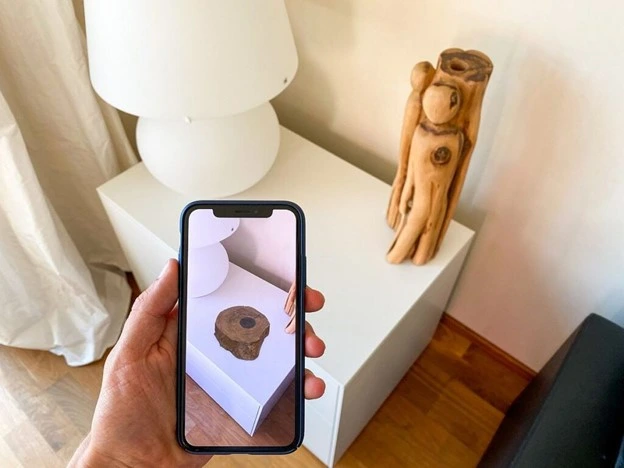Augmented reality (AR) and virtual reality (VR) are no longer the preserve of sci-fi movies and video games. Both technologies play very real roles in today’s retail experience and are among the tech that are revolutionising online customer experiences. These roles will become even more prominent and popular over the coming years. The applications are plentiful and benefits considerable, yet many ecommerce brands still have not adopted the technology. Here’s why they should.
How Can Brands Incorporate AR and VR into Online Shopping?
There is no shortage of ways brands can incorporate AR and VR into the online shopping experience.
Trying Items Before Purchase
The most well-known application of augmented reality in the ecommerce sector is virtual try-on solutions or VTOs. These virtual tools make it easier for customers to make informed purchase decisions, while brands can better manage customer expectations.
“In short, a virtual try-on is the way a customer can “try-on” a product through mobile or other devices equipped with a camera,” explains Aleksandra Kwiecien, a content manager at Infermedica and former content manager at Divante. “Thanks to the underlying AR technology, future customers can see themselves in a beloved product on the screen of their smartphone.”
“Virtual try-on technology has been around for a while,” she writes. “But the development of facial recognition, thanks to the rise of social media filters, has helped its popularity to soar.”
“These applications drive cross-channel web traffic and attract consumers seeking enhanced shopping experiences,” explains digital marketing expert Ralf Llanasas. “From the shopper’s perspective, virtual try-on solutions are revolutionary solutions for retailers dealing in jewellery, eyeglasses, shoes, clothes, and more.”
VTOs are not the only way customers can trial products before purchase. Augmented reality also allows customers to see how a physical object will look in real-world surroundings, writes Ravi Sharma, Founder, and CEO at digital agency Webomaze. This is particularly powerful in the decor industry, he says. “By accessing this particular technology, the buyers can figure out how a sofa might appear after placement in the house.”
Recreating the In-Store Experience
Virtual reality can be used to bridge the gap between traditional stores and online shopping, says Red Stag Fulfillment’s Jake Rheude. “In a brick-and-mortar store, a retailer can draw customers in by creating an appealing environment with fun music and dynamic product displays.” That is usually not possible online unless brands use VR to showcase their products in virtual environments that show how customers can use them. VR allows brands to build an aspirational world that customers can enter when they purchase the product, Rheude explains.
The social aspect of shopping can also be recreated online using VR, writes Jake Hughes at keyword tool Wordtracker. “You can walk around the VR store with your friends in real-time, interact with 3D products, with each other, and ask a virtual member of staff if you need help with something.”
Building Buzz
AR and VR do not have to be directly tied to the sales process. The technology can also be used to build brand awareness and create industry buzz, says Tom Sharman, Co-Founder of talent management and consultancy New Waves.
He offers the imaginary example of Ford creating a VR racing game. While not directly encouraging customers to buy a new car, the game could offer a glimpse of what it’s like to drive a Mustang.
Interactive User Manuals
Another non-sales-related application of AR is interactive user manuals. The process is simple, writes the team at image editing service PixelPhant. By using an app to scan a product like a coffee machine, users get a virtual walkthrough of their product, learn how it works, and explore features.
This kind of application can reduce stress on your post-sales support teams, the team adds. “Teaching your customers about your products not only makes them aware of you and tell them ‘how-to’ but it also reduces your customer support load and improves engagement.”

How Do AR and VR Benefit Brands?
Both augmented reality and virtual reality have real, measurable benefits to ecommerce brands. These benefits directly impact sales, customer satisfaction levels and other key metrics.
Remove Friction from the Customer Journey
There is still some friction in the online buyer journey, despite the rapid acceleration of ecommerce adoption. AR and VR go some way to reducing that friction, says Rebekah Carter at extended reality news publication XR Today. “Rather than having to take a gamble and potentially send a pair of sunglasses back if they don’t look good, your customers can try the products they like on with AR instead,” she writes.
Customers can also use VTO technology to find answers to their queries without having to speak to customer service. For example, they can get an idea of the dimensions of a sofa by virtually placing it in their room.
Reduce Returns
AR and VR technology can also help reduce returns. “Try-before-you-buy AR initiatives represent an exciting opportunity to help reduce return rates in the fashion industry,”’ writes Swanky Agency’s Hannah Leary. “Giving shoppers a chance to visualize a product and even try it on (albeit virtually), should make them feel more confident in their purchasing decision and eliminate the need to buy multiple versions of one product.”
Improve Digital Marketing Efforts
AR and VR may also go some way to improving online marketing efforts in the future. Facebook is already piloting AR ecommerce ads, writes Vince Cacace, Founder and CEO at 3D and AR commerce solutions provider Vertebrae.
Google is also looking at incorporating AR product images into both paid and organic search results. “When users click on the View in 3D button, they can either interact with your three-dimensional virtual product or ‘place’ it in their real-world environment with AR,” explains Ulyana Paliychuk at business automation solutions provider Evergreen. “At this point, they can either proceed to your website or return to the results page.”
Which Ecommerce Brands are Already Using AR and VR?
Some brands are better suited to using AR and VR than others. The benefits of the technology are most suited to products where aesthetics or size are key factors in purchase decisions, writes Aurora Harley, Senior User Experience Specialist at Nielsen Norman Group. “Home décor and furniture are top candidates to get the AR treatment, as people want to ensure that these items would fit in their space and match their overall style.”
Sephora
Sephora’s Virtual Artist is a great example of how to use augmented reality in ecommerce. The tool “allows customers to try on thousands of shades of lipstick, eyeshadow, false lashes, and many other makeup products sold at Sephora,” explains Alison DeNisco Rayome, a Senior Editor at CNET. “It also lets users go through beauty tutorials on their own face digitally to learn how to achieve certain looks. A new feature called Color Match taps AI to help customers find the right colour shade for their skin tone via an uploaded photo.”
IKEA
The IKEA app lets customers see what almost any piece of furniture they sell will look like in their homes. The app uses AR technology to render a 3D image of the furniture in the room using the smartphone’s camera. Shoppers can also reposition the furniture wherever they like.
MOSCOT
A partnership with AR and VR leader Vertebrae, allows fashion brand MOSCOT to deliver VTO to eyewear customers without an app.
“Vertebrae shares our commitment to quality and excellence, and it was an easy decision to partner with their team to manage and deploy 3D and AR in keeping with the service we have offered to our clients for over a century,” says Zack Moscot, Chief Design Officer at MOSCOT. “Our initial results are strong, and we are excited about extending our implementation to bring our timeless style and extraordinary quality to life for digital shoppers.”
The Time for AR and VR is Now
AR and VR are no longer fringe technologies. It is not just the examples above that are fuelling the growth of these technologies in ecommerce, either.
The pandemic is also accelerating the use of AR and VR. Ulta’s VTO tool GLAMlab saw engagement increase seven-fold since the start of the pandemic, writes Helen Papagiannis, Ph.D., founder of consultancy and digital magazine XR Goes Pop. Customers have swatched more than 50 million foundation shades using the app.
Social media platforms are another driver, writes Maria Monteros, Associate Editor at Retail Dive. Snapchat, in particular, is betting big on AR and VR by partnering with brands and tech companies to allow users to try on products in-app. It also recently acquired Screenshop, a fashion recommendation app, and Fit Analytics, a sizing tech company.
There is plenty of room for growth. Grand View Research put a value of $15.81 billion on the global virtual reality market size in 2020 and expects it to grow at a compound annual growth rate of 18% until 2028. Growth in the industry will allow ecommerce brands to continue to incorporate AR and VR into the online shopping experience, evolving in ways designed to delight customers.
If your brand is ready to embrace and leverage the bold future of DTC ecommerce, talk to an ESW expert. From fast internationalisation to building your store from the ground up, ESW has the solutions for market entry and sustained success.





